Carrying out major repairs in the kitchen, or making its partial reconstruction, it often becomes a question of what material to choose for arranging the floor. It should be easy to wash, serve for at least 10 years, and at the same time be durable and beautiful. After all, all coatings in the kitchen are constantly exposed to all kinds of influences. When cooking, all kinds of liquids, fats, detergents fall on it, items of kitchen utensils, cups fall.
Ceramic tiles on the floor in the kitchen, ideal for arranging such a coating. But when choosing such material, you should know several important points. What thickness to choose the tiles, size, what should be the thickness of the coating, the material from which the top layer is made (glaze). Product resistance to aggressive environments and repeated exposure to detergents. This is where a number of questions arise that need to be fully dealt with.
When choosing a tile, it is necessary to build on the size of the kitchen itself, the entire floor surface will not look beautiful if you choose a large (540 * 540 mm.) Tile, in a small kitchen up to 2 meters wide. Part of the surface will be covered with kitchen furniture, some will go under the table and chairs, and a small strip will remain. Especially not to choose a ceramic coating with a large pattern. But there is a way out, let's take a closer look at what and how to choose.
- An excellent option would be to use in such cases plates from natural materials with dimensions 800 * 800, 1000 * 1000 and 1000 * 1200 mm. The choice of such a coating is large and it will not be difficult to find a beautiful texture. The thickness of such a plate is 8-20 mm. Perfect for any high performance surfaces, kitchens, studio living rooms and corridors.
- You can choose tile options for a natural stone, with a large size, without edging and an expressive geometric pattern, and also put a small tile 100 * 100, 200 * 200 mm, 300 * 300 mm. Covering the entire floor space by choosing plain or fine textured ceramic tiles.
- An intermediate option is also possible ceramic coating with dimensions 200 * 400 mm, 250 * 500 or 300 * 600 mm. But then the masonry method must be selected carefully, in length with a breakdown at the seams, masonry diagonally, or just joint to joint. Tiles with a wood-like texture can be laid both across and along the kitchen, but it is better all the same along.
With medium-sized and large kitchen areas, there are no such problems in the selection of tiles. It is not recommended to use too small a size of ceramic products (100 * 100 mm), ceramic tiles will visually merge into one canvas.
What type of tiles is best for the kitchen
Several years ago, a durable and relatively inexpensive tile, gres, appeared. When choosing any kind of products from glazed gres, red clay or porcelain stoneware, specify the class. The first 3 are suitable for cladding indoor surfaces, the remaining 2 outside. The floor surface in the kitchen should not be slippery, this type has proven itself well in this. But there is one point that must be taken into account, for the kitchen it is better to buy a glazed version. Pores with uncoated tile glaze can absorb grease, leaving dark stains that are difficult to remove. Otherwise, this tile is noteworthy.

With glossy or textured (porcelain stoneware) ceramic tile surfaces, there are no such problems. Thin layer special coating will not allow dirt to penetrate into the structure, remaining on the surface. Such ceramics are easy to clean and serve for a long time without requiring special care or protection.
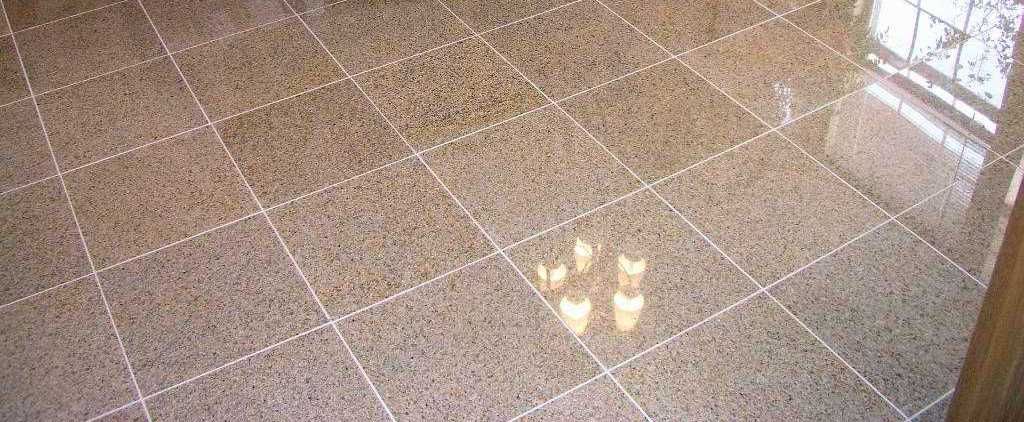
Tip: Choosing a glossy look of tiles for the kitchen, take care of the right choice kitchen furniture... Without special inserts on the legs, furniture can scratch the glossy surface of the ceramic coating.
Coating and marking tiles
Ceramic tiles on the floor in the kitchen, selected according to some markings. Consider the required notation for correct selection ceramic coating.
Having dealt with the type, dimensions and designations of the surface in terms of quality, let's move closer to the masonry itself. We will analyze what tool we need, choose glue, and what you need to know about preparing the bearing surface.
Surface preparation for tiles
Moving on to the work of laying ceramic tiles on the floor, the quality of the bearing surface cannot be missed. The durability of the coating directly depends on its characteristics. Many have seen cracks in tiles, not just in the kitchen. There are several reasons here, we will consider each of them.

- Expansion tape not laid along the edge concrete preparation (diphthong, proclamine). With temperature changes, all walls contract and expand, subjecting the bearing surface to excessive stress. As a result, cracks inside the base, chips, flaking of tiles.
- A poorly primed preparation surface also has negative consequences. In this case, the tile can creak, peel off together with the mortar, and burst under heavy loads. Excessive soil coverage also leads to negative consequences. The film formed on the surface impairs adhesion and bond quality.
- The edges of the tiles when laying tightly against the wall, the factors are the same as described above, the expansion of materials, leading to stress on the surface of the tile.
It is not difficult to prepare the surface yourself. You will need a foam roller with a holder, a bucket, a primer bath, along the width of the roller, a brush, a broom or a vacuum cleaner. Two spatulas, 100 and 350 mm wide.
Old surfaces are characterized by cracking of the base surface. Everything is simple here, embroider the seams with a spatula, remove the pieces of mortar from the cracks. The surface is primed with a roller in one layer, crevices with a brush.
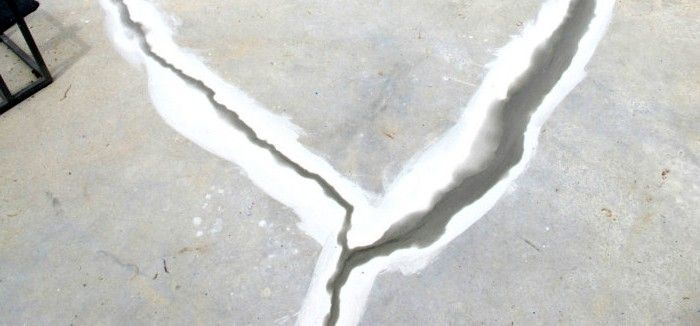
Tip: The primer is not used in its original form, but diluted with water, in a ratio of 8: 2, where 8 parts of soil, and 2 parts of water. This is how deep penetration into the pores of the solution is achieved. After 8 hours, the previously embroidered seams can be putty.
Sealing adhesive is used on the basis of cement. With a trowel, you can smooth out unevenness in the floor caused by joining. In a day, the floor surface is ready for laying ceramic tiles.
How to put ceramic tiles on the kitchen floor with your own hands
The tool and materials are prepared in advance for all the upcoming work. There is not much of it:
- Square for marking right angles. Level 2 m, and another small up to 80 cm, check the level between the tiles during the laying process.
- Roulette 5 m, pencil or marker.
- Rubber hammer weighing 500-600 grams.
- Cord with dye, beat straight lines, over a long distance, there is one in any building materials store.
- Bucket for solution preparation.
- Drill with attachment (mixer), grinder with a circle diameter of 125-150 mm.
- A diamond disc, a file to remove possible deposits of enamel from the ends of the tiles.
- Crosses for seams 2-3 mm thick.
- Notched trowel 200 mm wide, tile cutter.
- Personal protective equipment: glasses, rubberized gloves, respirator.
 It is necessary to carry out an accurate calculation of the masonry mix. For a standard layer of 5 mm, the consumption of glue is 4.8-6.0 kg, per square meter. If the difference reaches more than one centimeter, and it is easy to check this with a 2-meter level. Calculations are made as follows, take the average thickness. For example, in one corner it is 1.2 cm, and in the other 0.5. The indicators are matched 1.2 + 0.5 \u003d 1.7, the result is divided in half. The average glue thickness is 8.5 mm. This means that the coefficient for the purchase of glue will be 1.5, one square meter of ceramic tiles will need 8.5-9.0 kg of dry mixture.
It is necessary to carry out an accurate calculation of the masonry mix. For a standard layer of 5 mm, the consumption of glue is 4.8-6.0 kg, per square meter. If the difference reaches more than one centimeter, and it is easy to check this with a 2-meter level. Calculations are made as follows, take the average thickness. For example, in one corner it is 1.2 cm, and in the other 0.5. The indicators are matched 1.2 + 0.5 \u003d 1.7, the result is divided in half. The average glue thickness is 8.5 mm. This means that the coefficient for the purchase of glue will be 1.5, one square meter of ceramic tiles will need 8.5-9.0 kg of dry mixture.
The tile is calculated based on the size of the room, plus a percentage for trimming is given, up to 3%. For example, a kitchen 2.5 * 4.5 meters, tiles measuring 30 * 30 cm, seams 3 mm. We divide the width by 33 mm, taking into account the crosses for the seam. We get 8 and a quarter of the tiles, but a gap between the wall is needed, and even less tiles will go. The length will be 14.85 tiles, but taking into account the exit to the threshold, all 15.
So, we take integer values \u200b\u200b9 * 15 \u003d 45 tiles for the kitchen, taking into account all the cuts. This is more than enough.
Ceramic tiles on the kitchen floor, being settled from the entrance to the far wall. There is usually furniture or a refrigerator. First, the diagonal of the room is checked and a line is drawn parallel to the wall where the door is installed. The distance from the wall is made at 1.0 cm. Then the corners are measured with a square, marks are placed and a perpendicular line is beaten off with a cord near the next wall. This will be the first stage after priming.
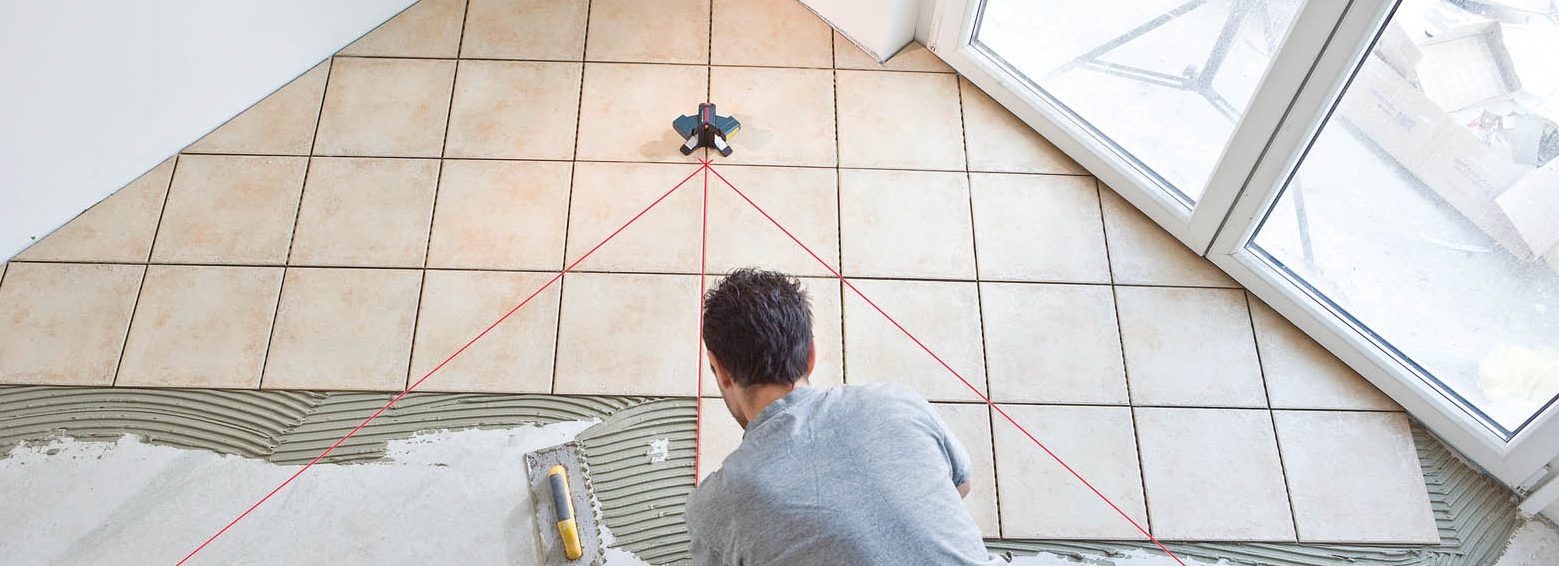
It is easier with styling, having prepared the glue solution according to the instructions, you can start the first row. It is the most important, the whole result depends on the accuracy of level measurements.
Spread the tiles over the entire plane with glue and remove excess mortar using a notched trowel. Then press the corner tile to the floor, while measuring the level in two directions. The diagonal is measured when they begin to lay the second row. Almost everything.
With the preparation of grout, difficulties arise not only for beginners, but also for experienced craftsmen... Technology is marching forward. Recently, epoxy, semi-composite and other binders have appeared. Each case requires a detailed approach to the issue of sealing joints. For the kitchen, it must definitely be moisture resistant and durable.

It is difficult to work with it without experience, having mixed a large amount, you risk throwing 20-30% of the mixture into the bucket. It will simply freeze. In this case, it must be kneaded in small batches of 150-200 grams. Unlike glue, where the finished mixture is poured into water, the grout is kneaded, on the contrary, water is added to it, little by little. The consistency should be like toothpaste or homemade sour cream.
You can apply grout with a rubber spatula, passing the seams first across, and then along, removing excess mortar. After 20 minutes, residues on the tiles can be removed with a slightly damp cloth. Correcting the seams themselves.
Important: Too liquid grout will sag after drying, resulting in uneven filling. The work will have to be done again.
- First, lay out the first row of tiles without mortar, insert all the crosses and see from which side it will be better to insert the trim.
- Adjust the tile along the length of the ledge, laying it on the door threshold, where the transition strip is subsequently installed. Lay out the markup.
- The tile tends to bend when wet from the solution. The first row should be laid as quickly as possible and allowed to shrink for 2 hours.
- Wipe the end of the tile with a damp cloth before laying, remove the mortar. Having got between the cross and the tile, it will create problems with dimensions in the future, there will be a gap. You will not be able to flatten the corners of the tiles already on the 4th row.
- When shrinking tiles on the mortar, press them to the floor until the air comes out of the mortar. You can tell by the sound on the second, third tile.
- Always wipe the level with a damp cloth, the solution, getting between the tile and the level, will lead to the fact that you cannot hold the plane.
- Remove the honey solution with stitches immediately, using an ordinary screw, after drying it is difficult to remove it. Remove all glue residues from the surface at once.
- When applying the solution to the tiles, follow the filling of the corners and the middle, poorly oiled corners can break during operation.
- It is impossible to grout the joints earlier than three days after laying.
- Wash the tool immediately, otherwise dry small pieces from previous mixes will fall off during the preparation of the solution. Having delivered a lot of hassle while applying glue to the tiles.

Ceramic surfaces do not require much maintenance, but there are restrictions on the use of some products. Do not wash the tiles with products containing abrasives. Pastes and gels containing such a component leave microscopic scratches. The normal appearance of the tile is lost if metal sponges are used. Otherwise, there are no restrictions.
When repair work many owners wonder what kind of kitchen they are. Indeed, the variety of products on the shelves of home improvement stores will mislead anyone.
Glass tiles look great on more than just walls
So let's figure it out!
Kitchen floor requirements
First of all, let's find out what requirements the kitchen floor must meet:
- The cover should be comfortable;
- Have hygiene;
- A high level of environmental friendliness;
- The floor must be lightly abraded;
- The cover must be washable and non-slip.
So, the requirements are listed, now let's move on to the tiled finishes.
Ceramic tile
Is a great option. Moreover, you can purchase both the glazed version and the unglazed one. The unglazed type is even preferable in that it most often has a "rough" surface that prevents slipping. Most often, floor options differ in relief and textured structure.
What I would like to protect from: When thinking about which tiles to put on the floor in the kitchen, do not opt \u200b\u200bfor porous options. Anyway, in the kitchen, something can spill on the floor, oil or wine, and then the tiles will be hopelessly damaged, since it will be problematic to remove the contaminant.
In addition, it is advisable to choose tiles of a not very large format, because the more joints, the less slippery the floor will be.
According to the production method, the tile is divided into:
- Extruded. This type is made by extrusion, that is, through the hole, the mass is squeezed out onto the surface, and then it is fired;
- Pressed. The solution includes special binders and fillers. The mixture is poured into a mold, then it is fed into a unit, where it is pressed, and only then it is fired in a special oven.
According to the type of processing, the choice of tiles for the kitchen can be based on the following options:
- Monoporosis. The production method includes a single firing and then glazing. The tile will not be durable, therefore it is not suitable for the floor;
- Monocotture. And this type of coating is created by pressing, and then - single firing. Quite sturdy tile;
- Bikottura. It differs from monocotture only in that it provides for double firing, but this does not mean that the quality is increasing. The tile turns out to be porous, and the fortress is not at the level;
- Clinker. This type of production is also called extrusion. Thinking about what kind of tiles to put on the kitchen floor, if you have money, stop your choice on it, since such a tile does not absorb liquid, does not react to temperature changes, and is resistant to the effects of detergents. Clinker is a series of materials that are mixed with fired glaze and dyes. Then the mixture is pushed through a mold, then the mass is extruded, and then finally fired.
Here are the options that will help you choose your tile.
Porcelain stoneware
A great option for any flooring -. This tile is produced by pressing, it does not have a glazed surface, due to which it does not slip at all.
Among the indisputable advantages:
- Significant service life;
- Environmental friendliness;
- Ease of operation;
- Resistant to UV rays, mechanical and chemical influences;
- Various colors;
- Moisture resistance.
But there are also a number of disadvantages:
- With a point force, there is a possibility of a split;
- Coldness of the coating;
- In the presence of a glazed surface, wet tiles can slide;
- The need for alignment.
Think about the pros and cons, and decide which tiles to put on your kitchen floor.
Metlakh tiles
Despite the fact that it belongs to the unglazed ceramics produced by pressing, they are referred to as separate types. This is a rather expensive type of cladding, but the owners have the opportunity to create a whole work of art on the floor. Metlakh tiles are highly resistant to abrasion.
Polymer vinyl tiles
One of the interesting types demanded by the type of floor cladding. It is something like linoleum tiles, only stronger.
Among the cons:
- Instability before exposure to fatty solutions;
- Medium resistance to chemicals (detergents, abrasives, etc.).
And even the fact that this type of tile can be created in two or three layers does not in any way make it better than classic tiles. So think twice before choosing this floor covering.
Glass tiles
The newest flooring option to consider when choosing which tiles to put on your kitchen floor. Yes, it does not have excellent resistance to point mechanical stress, but its shape is perfectly even, it perfectly repels dirt. Due to the fact that the design is applied to the inner layer, which is then covered with a transparent coating, the design does not fade and does not wear out.
In addition, some of these finishes are equipped with built-in LEDs, which give the finish a special charm.
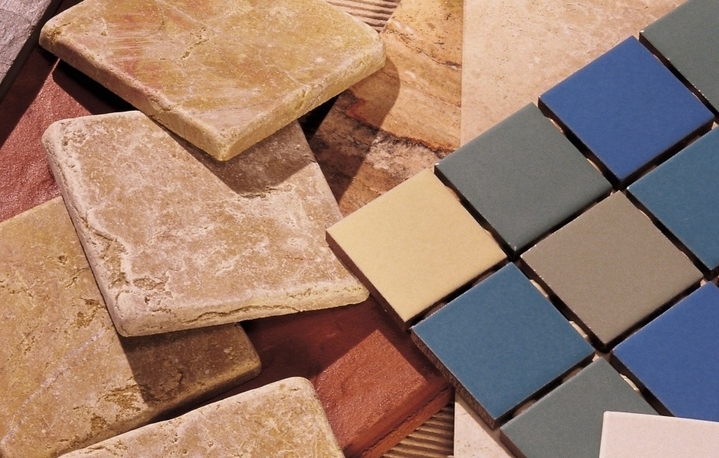
Cladding options
So now you have options to decide which one is in the kitchen. Happy choice!
Anyone who decides to make their kitchen cozy and beautiful will definitely think about what kind of tiles to put on the kitchen floor. It is difficult to imagine a more suitable floor covering for such a specific room.
The construction market can offer a huge number of manufacturers - from the most fashionable and elite to budget. A rich selection of colors, patterns, textures and materials allows you to bring to life the most daring design ideas.
Floor tiles, in contrast to wall tiles, have better performance characteristics. The main property floor tiles can be considered increased impact resistance and resistance to other mechanical damage and stress.
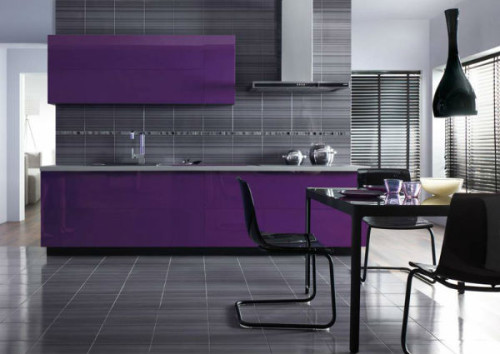
It is quite difficult to assess the strength and durability of the tiles you like by eye, so first of all you need to read the information provided by the manufacturer. Before going to the store, it is advisable to familiarize yourself with the existing classification and standards by which you can determine the quality. For the kitchen, tiles of class 5 and 3 are desirable, wear resistance class - A or AA.
Advice! You can choose a strong and high-quality tile based on its weight - the heavier the tile, the stronger it is. When laying, heavy tiles will not be easy to cut, but they will last much longer.
It's no secret that tiles can be very slippery - a drop of fat or oil can literally turn kitchen floors into a skating rink, which is very traumatic. Therefore, in the cooking area, it is better to avoid a glossy finish, and opt for a matte texture with an anti-slip layer. High quality tiles with a rough texture are not clogged with dirt and dust, easy to clean and clean.
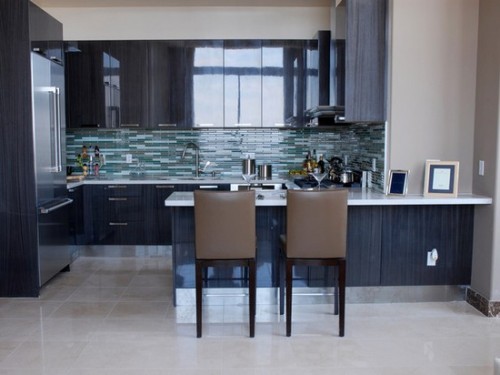
According to the safety factor, all floor tiles are divided into 4 classes:
- if the friction coefficient is more than 0.75, the tile is safe;
- coefficient 0.39-0.74 - relative safety;
- 0.19-0.39 - dangerous;
- up to 0.19 - the tile is very dangerous.
When deciding which tiles are best to put on the kitchen floor, especially in working area, the safety factor should be considered not least.
Advice!It is best to purchase tiles in specialized stores, where qualified sales consultants can provide all the information and necessary certificates, as well as give competent advice.
Selection by color and size
In a small kitchen, it is better to lay medium or small tiles, since large tiles will visually reduce an already small room. In addition, small pieces on the floor will give the kitchen extra elegance and grace.
![]()
On the other hand, larger tiles are much faster and easier to install. Cleaning of tile joints is also easier on large tiles.
Advice! When purchasing a tile, be sure to make sure that the geometric parameters correspond to those stated. When laying, a difference of even one and a half millimeters can be significant.
The choice of color is strictly individual, but the recommendations of experts say that the floor covering should be one tone or half tone lighter than the main interior of the room. Any dirt will be noticeable on a surface that is too light, and all small scratches and dust particles are clearly visible on a too dark surface. The golden mean can be considered a non-uniform surface with imitation of stone, wood or cork.
Advice! A diagonal and checkerboard pattern of tile placement will help to visually narrow or expand the kitchen space. Tile grout in a darker color will visually expand the floor, while grouting to match will create the effect of a single surface.
Types of floor tiles
Before choosing a floor tile for the kitchen , it is desirable to get acquainted with existing species ceramics. According to the manufacturing method, tiles are divided into pressed and extruded. Unglazed tiles will have a uniform structure, the composition of glazed tiles is less uniform. The surface can be embossed, textured and smooth.
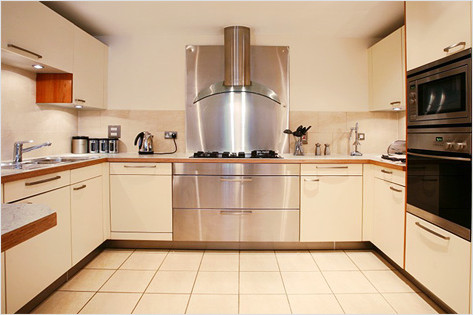
Ceramic (tile) tiles
It is the most popular floor covering produced by firing sand, clay and minerals by extrusion. After firing, a layer of dyes and glaze is applied alternately to the tiles. A completely democratic price is combined with a huge selection of colors and patterns.
The disadvantages of ceramics include the gradual fading of the coating and the requirement for absolutely even laying - when voids form under the tile, it will be covered with cracks. Transport also requires care and attention.
Porcelain stoneware
Porcelain stoneware can be called a more perfect type of tile. The composition is the same - sand, clay, mineral additives are pressed and fired, but dyes are added already at the stage of mixing the mixture. The result is a less porous surface than tiles.
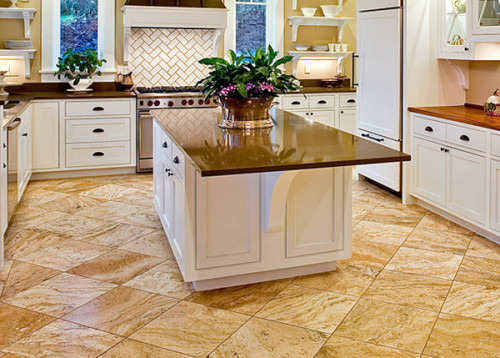
Porcelain stoneware is heavier and more durable. The service life of such a coating is calculated in decades. Despite the higher price, porcelain stoneware is popular with consumers in many countries. Cutting and installing porcelain stoneware is not easy, it will require the work of a professional.
Glass tiles
For people who value sophistication and beauty, the new innovative coating will be an excellent answer to the question. , what kind of tiles to put on the floor in the kitchen. In addition to its visual appeal, glass tiles have good performance characteristics. High strength and dirt-repellent properties are combined with a rich color palette and ease of installation.
The pattern is absolutely not subject to abrasion or fading, as it is applied to the inner layers of the tile, and the use of built-in LED backlighting will add special effect to the coating.
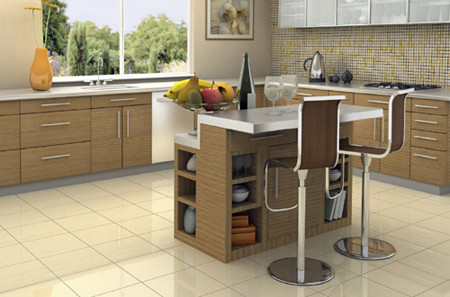
The standard thickness allows glass tiles to be successfully combined with other types of flooring. The tile is absolutely safe, since even with severe mechanical damage, the glass does not break into fragments.
PVC tile
PVC-based floor tiles for kitchens are considered one of the most unpretentious floor coverings. PVC tiles absolutely meet all hygienic requirements for kitchens: they are resistant to mechanical and chemical abrasion, easy to clean, easy to install.
The texture and color can be very diverse, including imitation of wood, leather, stone or carpet patterns.
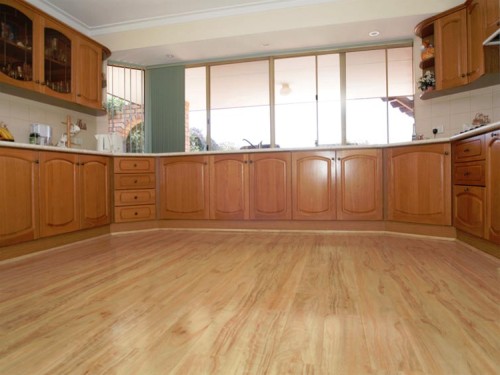
How to choose a tile for the kitchen floor and how it will fit into the overall design of the kitchen - this question worries everyone who wants to make a stylish and high-quality renovation. In any case, floor tiles are always a good decision of rationally thinking owners.
Tile - right choice floor material for the hallway. The coating here must be resistant to mechanical and chemical damage. The floor in the hallway is problematic; resistance to the effects of shoe soles, especially heels, is required. In addition, with shoes, we bring street dirt, sand, salt. Let's figure out which tile to choose for the floor in the corridor.
Advantages and disadvantages of ceramic coating
The unattractive appearance of a tiled floor is a thing of the past. The current variety of textures, colors, prices allows you to embody any design solutions in the hallway. The corridor expands, lengthens, focuses on the center - as the soul wishes. The texture copies a wooden cut, stone, fabric. In terms of fantasy ideas, tiles are an excellent material. It remains to decide how to choose ceramic floor tiles.
No parquet or super laminate can match the strength and stability of tiles. High performance characteristics are indisputable - the tiles are easy to care for, the room is always clean and tidy.
Your interior will visually benefit. It doesn't matter which tile to choose in the corridor - expensive or cheaper, the high cost effect will definitely play a role. The coating can look aesthetically and neatly for many years.
The main disadvantage of ceramics is that they are uncomfortably cold and hard. Barefoot does not feel home comfort. There is a risk of giving the interior a dull mood with a taste of "official". We offer several ways to fight:
- install a floor heating system in the corridor;
- tile the small piece near the front door. Zoning is important for large hallways;
- apply woodgrain tiles to simulate cozy parquet flooring.
We make a decision: which tile to choose for the floor in the corridor
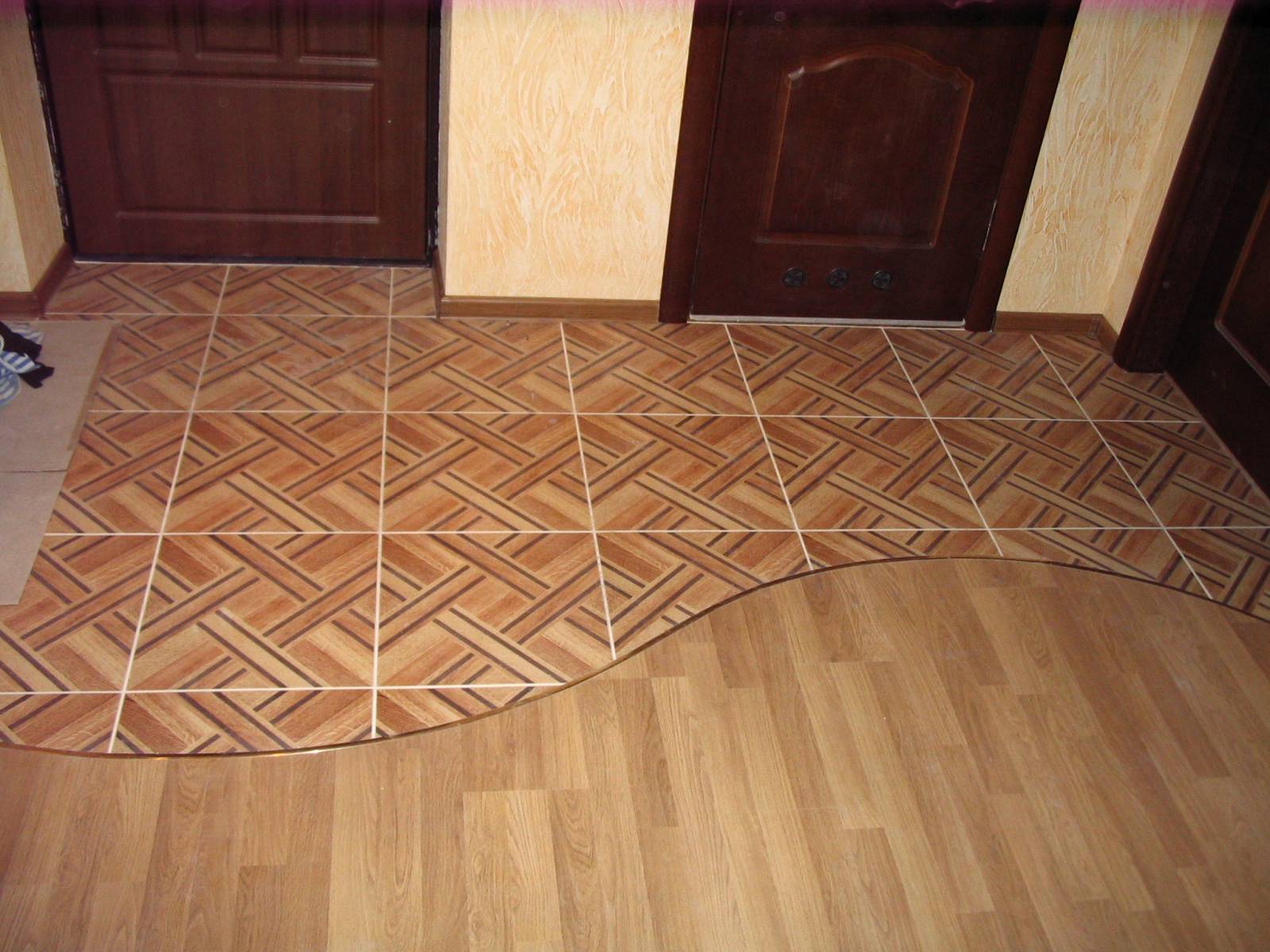
Specifications
- Resistance to mechanical abrasion, shock. The load in the hallway is the highest, this negatively affects the condition of the floor covering. There is an international division into five classes of wear resistance. Pay attention to the labeling, buy the material with the highest performance: REI 4 and REI 5.
- The floor in the hallway is a collection of street rubbish and dirt. So what kind of tiles to put in a corridor that requires frequent washing with powerful gels and powders? Maximum resistance to abrasive substances, aggressive household chemicals marked with the letters AA. It is also permissible to cover the floor in the corridor with cladding with anti-chemical protection indicators A and B.
- Resisting wet and dirty shoes will provide low water absorption. Moisture resistance is achieved during the firing process, for "corridor" tiles the indicator does not exceed 3%. We define it visually as follows: the chip of the material has a red color, a smooth non-porous structure.
- The anti-slip indicator is taken into account. For tiles in the corridor, levels R10 and R11 are suitable. The coefficient of friction is not less than 0.75. Before choosing a tile for the floor in the hallway, pay attention to the coverage of the proposed items. Ideal: matte finish, rough, embossed surface.
Turn away from beautiful, mirror-like gloss. A slippery surface will turn into a real roller at the slightest moisture penetration. After a while, the shine will fade, in visible places it will acquire a worn out, unsightly appearance.
When faced with a choice of which tiles to put in the hallway, opt for durable embossed ceramics that are indifferent to the effects of water and chemicals.
Size matters
An important question is what size of tiles to choose for the floor. Smaller tiles are cut less when laid, meaning savings on material. They look cozy.
Large tiles can be installed faster and easier. It has fewer seams where moisture, debris, dust gets. Subsequently, these gaps do not look aesthetically pleasing, and material with low moisture resistance wears out faster.
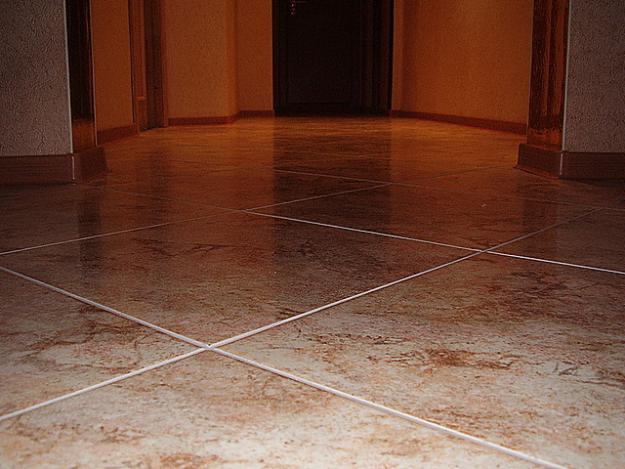
The size of the tile to choose depends on the footage of the room. For a small hallway, use small square shapes. They conceal oblongness. A large spacious corridor allows you to tile with imagination, tiles of any size are suitable here, large ceramics look gorgeous.
Attention to colors
Light colors are impractical, especially if texture is present. Over time, difficult-to-clean dirt-dust will be hammered into the relief and grouting joints. The use of abrasives in this case will negatively affect the coating of the tiles.
Let the dark shade not be saturated - possible chips, scratches are so noticeable. Dust is perfectly visible on black tiles.
Cold light colors will make the hallway more spacious, warm ones will give coziness, dark tiles will visually limit the space. Find your compromise when deciding which tiles to choose for the floor in the hallway. For example, take a light tile with a variegated pattern in a dark tone.
Choose the color of the tiles in accordance with the color of the covering of the rest of the rooms. Or play on contrasts by strengthening zoning.
Avoid unnecessary brightness. Multicolor visually reduces space. Optimal colors: beige, gray, coffee.
Which tiles to put on the floor in the corridor is up to you, but do not forget: the tile pattern must be in harmony with the wall decoration.
![]()
Porcelain stoneware
A frequent question: which tile to choose in the hallway implies a choice - it will be tile or porcelain stoneware. The main advantage of the latter is super strength and wear resistance. The manufacturing technology is such that paint and pattern are applied through all layers of tiles. Scratches do not spoil the appearance, chips are invisible, since the material has the same color at all levels. The coloring of porcelain stoneware is simple, monochromatic, there is no variety in patterns, like tiles.
Tile layout
When determining which tiles to choose on the floor in the hallway, think about the layout method.
- Normal stacking in rows is a simple, affordable method. If there are no color schemes, the tiles do not differ in originality, such laying looks boring. It is convenient to use for large-sized ceramics.
- The brick where the offset is used is suitable for rectangular shapes... Tiles of different colors are originally combined in such masonry.


- Parquet installation - for wood-like ceramics.
- Complex modular installation requires effort and experience. A pattern is laid out in the center, a drawing around which the rest of the elements are located.
- Beautiful diagonal laying hides wall defects (eg non-parallelism). Expands the space, requires skills from the master.
Lay square tiles in two contrasting colors in a checkerboard pattern. Plain in-line masonry, and the effect is amazing!
Combined solutions look interesting on a large area:
- make a mosaic tile edging;
- lay out the panel in the center of the site;
- diversify the laying of a single-colored tile by laying it out in sections at different angles: line perpendiculars to the walls in the center, edging with diagonal laying;
- for a narrow hallway, take tiles in two contrasting colors. The alternation of dark and light stripes will expand the hallway;
- diagonal laying will create the appearance of an expanded space.
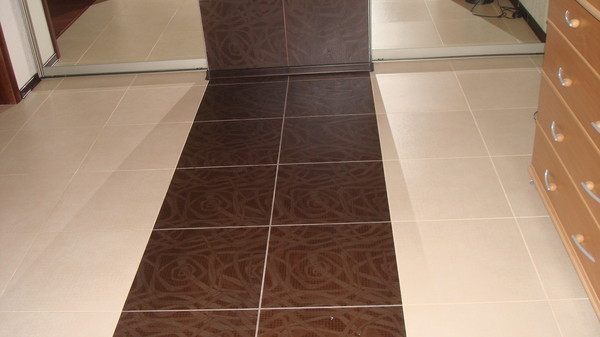
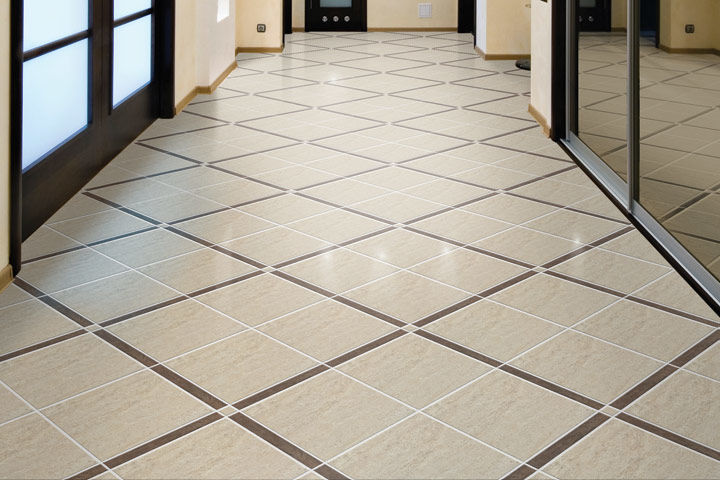
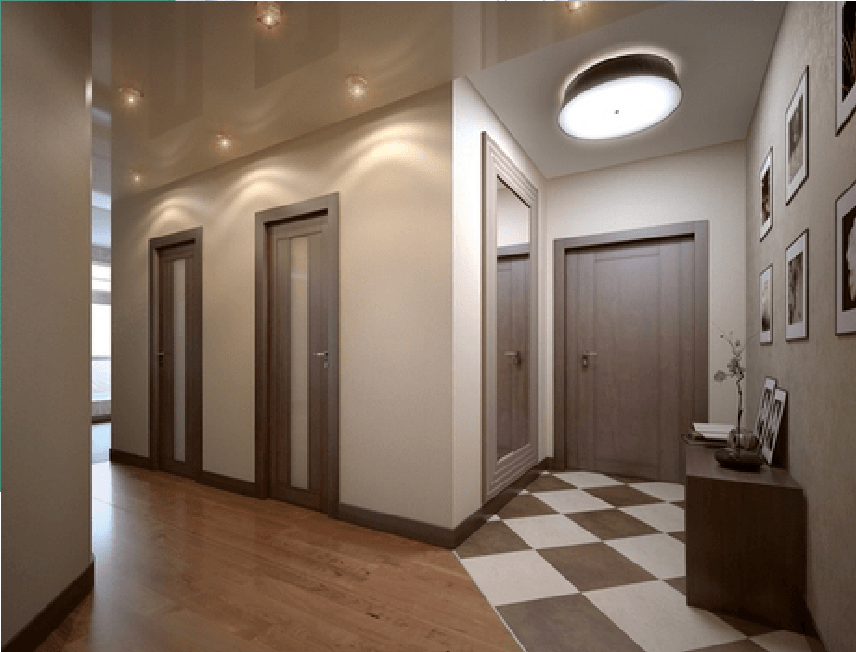
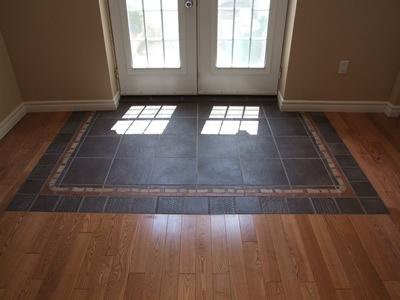
Fresh ideas on what kind of tiles to put on the floor in the hallway
Zoning the room: select a corner for shoes and, separately, a meeting place for guests, laying it out more elegantly.
Move away from hackneyed decisions. Replace standard shapes with stylized ones, dilute with mosaics, ceramic decor.
Think about what kind of tiles to put on your hallway floor without losing out on aesthetics. Remember to match with wall decoration.
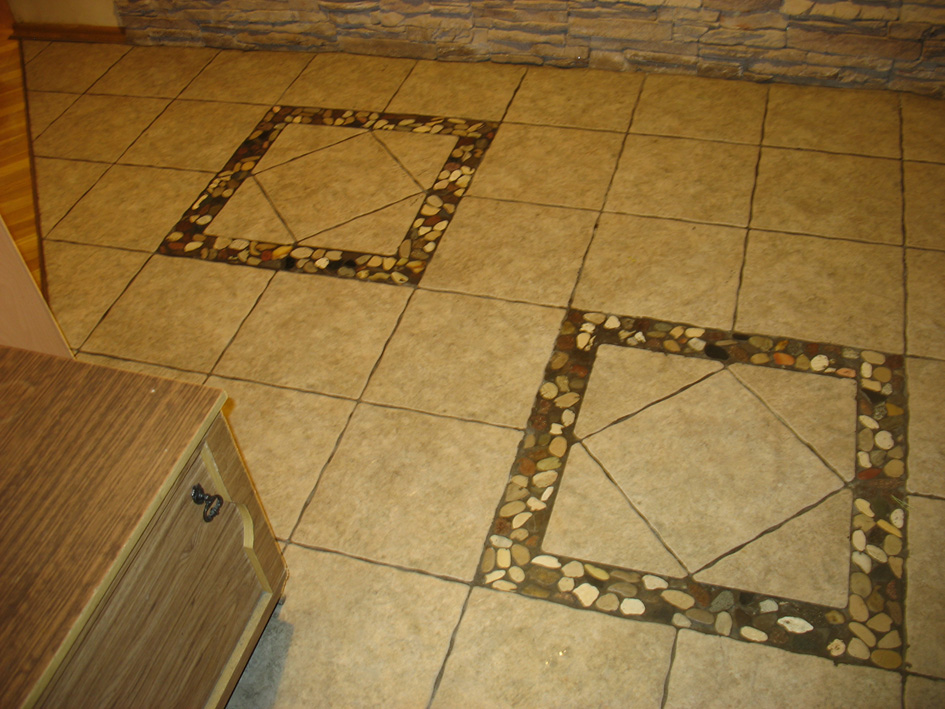
The combination of tiles and laminate in the hallway looks interesting. A successful zoning option without the use of partitions and other structures. Draw a straight line, connect the two covers with a bend (which is more difficult to implement).
Having figured out which tiles to buy for the floor in the corridor, do not forget about the ceramic frieze. The plastic skirting board along the ceramic floor looks cheap.
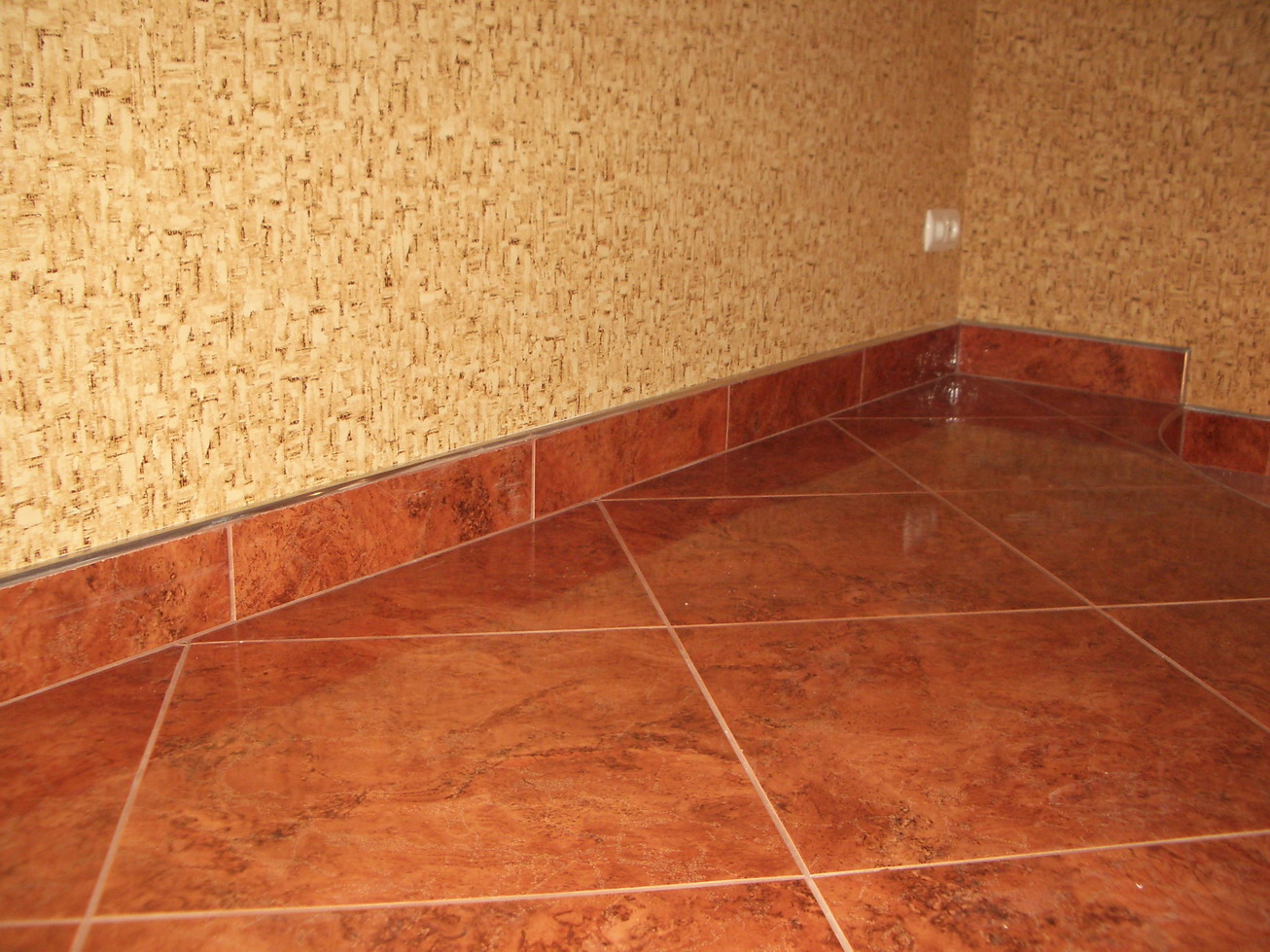
The entrance hall is the first room that everyone who enters the house sees. The question of which tile to choose for the floor in the corridor should not be reduced to a practical assessment of the technical indicators of durability-strength-stability-sliding. No less important is the aesthetic component, the originality of the design of the floor covering. Do not make a decision alone, ask experienced friends for advice on how to choose tile for the floor. Consider different opinions to form your own.
Greetings, dear readers, today we want to talk about such a difficult topic as the choice of flooring in the kitchen. What is better to put on the floor in the kitchen - this question is asked by all those who decided to make repairs in the kitchen room. And there really is something to think about - in the kitchen, the flooring will face aggressive external influences, be it strong temperature changes, high humidity, various smells and physical influences, in the form of dropped plates and spoons. And such a floor should still be easy to use and maintain, right? This is such a difficult task before us. If you do not want your floor to become unusable within 1-2 years, we recommend that you carefully read our article to the end.
First, we will get acquainted with the most popular types of flooring, consider their pros and cons, and then choose the option that best suits our criteria.
Let's consider what advantages our floor should have in an ideal version:
- Moisture and water resistance. A spilled soup, a tumbled mug of water, or just boiling water in a saucepan is what our flooring will face every day.
- Safety and hygiene. Resistant to the use of aggressive detergents.
- Durable and wear-resistant material. Maintaining an attractive appearance for many years.
- Resistance to physical influences. Unfortunately, most materials do not have the required strength.
We have a rather large list, right? The coverage we choose must meet at least two of the requirements from this list. But in addition to these undoubtedly useful qualities, you also need to take into account the price of the product and its appearance.
Ceramic tile
Pros of tiles as flooring:
- Nice appearance.
- Resistant to moisture and water.
- Not afraid of external aggressive influences - detergents, solar activity, fats and temperature extremes.
- Does not deform and practically does not lose its appearance.
- Fast and easy cleaning.
As you can see, the advantages are quite significant and we suggest that you take note of this option.
Examples of laying tiles in the kitchen
But before opting for this material, we suggest you familiarize yourself with the disadvantages of flooring:
- Ceramics do not tolerate heavy physical impact, for example, if a cast-iron frying pan falls, the tiles will surely crack. Stone tiles are much more impact-resistant, but they have a significant drawback - the price.
- Fallen dishes in 95% of cases will not survive the impact and break.
- Coldest cover, barefoot on ceramic tiles not very comfortable. Warm under the tiles - in this article you can read which warm floor suits best under the tiles and how to install it. If a warm floor is not suitable for you, then you can lay a carpet on the covering.
Parquet flooring
Now let's talk about such a wonderful coating as parquet board. We have described in great detail all the pros and cons in the article “Parquet or laminate? What's better? ". Here, we will take a quick look at the main pros and cons.
Let's start with the pros:
- The wooden flooring creates a unique coziness in the kitchen.
- The wood floors are warm and comfortable.
- A huge variety of colors, textures and styling methods.
- Environmental friendliness.
- Moisture resistance, but only for a short period of time.

Parquet board looks nice and expensive
Now let's talk about the cons of a parquet board:
- Afraid of prolonged contact with water (several hours).
- Strong physical influences can leave marks on the coating and restoration of the canvas is required.
- The main disadvantage is the high price compared to other types of coatings.
Laminate in the kitchen
In this article, we will not touch upon expensive types of laminate, which include class 31-33, which has increased wear and moisture resistance. You can learn more about the advantages of laminate flooring in the article - "Choosing a laminate". Here we will briefly review the main advantages and disadvantages of the coating.
Pros of laminate:
- Imitation of other floor coverings - tiles, wood, etc.
- Low product price.
- Not afraid of exposure to high temperatures.
- Possibility of replacing the damaged area.

Laminate in the kitchen
Cons of laminate flooring in the kitchen:
- Synthetic material, not natural.
- Under the influence of water and moisture, it deforms and swells.
- Cheap models are very easily damaged.
- A real dust collector - synthetics are electrified and attract dust.
- It is afraid of the effects of cleaning agents and gets dirty easily.
Project owner advice. Dear readers, my kitchen has laminated flooring and I strongly recommend that you do not use this flooring in the kitchen. Grease stains are hard to rub off, the corners of the laminate in some places have chipped off, and in some places the coating has swollen. Unfortunately the apartment was bought with such a covering in the kitchen room and the laminate was installed of poor quality. There are no such problems with more expensive models. As soon as possible, the cover will be replaced with a more suitable one.
Linoleum is the most practical and cheapest option
We talked in detail about linoleum in the article - "laminate or linoleum". Here we will touch on the main advantages and disadvantages of the coating. In the same category, we include PVC tiles, which have the same characteristics and properties as linoleum.
First, about the pros:
- Excellent water resistance.
- Wear resistance.
- Not afraid of falling heavy objects.
- Cheap product price.
- Soft and warm.
- A wide range of colors and patterns (see photo).
- Easy to clean and wash.

Variety of colors and patterns
Now let's talk about the cons:
- Afraid of exposure to high temperatures.
- Afraid of harsh cleaning agents.
- There is a possibility that the coating will break or cut.
- Fading and attracting dust.
- Synthetics.
In fairness, it is worth noting that all these disadvantages relate to the vinyl coating, but real linoleum, the so-called marmoleum, is devoid of these shortcomings. Unfortunately, natural linoleum is much more expensive than its synthetic counterpart.
We recommend that you combine flooring in your kitchen using the strengths of each flooring. In addition to practicality, you can visually divide the kitchen into two zones, for example, a cooking and eating area. It is very practical to lay tiles near the stove and sink, and in the place where the dining table will be, lay parquet or good laminate... Let's take a closer look at what you need to know when zoning a kitchen. This option is also great for the hallway.
- Suitable coatings for the cooking area: ceramic and stone tiles, PVC tiles and linoleum.
- Finishes suitable for the dining area: parquet, laminate, bamboo.
- The thickness of the coatings must be the same.
- It is very important to make a beautiful transition of two floor coverings, we talked about this in detail in the article “How to join parquet and tiles”.

Combination is the best option
Dear readers, I hope you enjoyed our article, please click on one of the social media buttons under the video, this will help the resource develop. Thanks for reading, see you in the next article.
Video
In contact with



